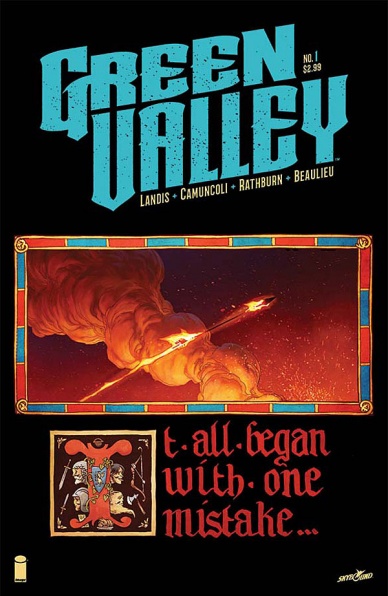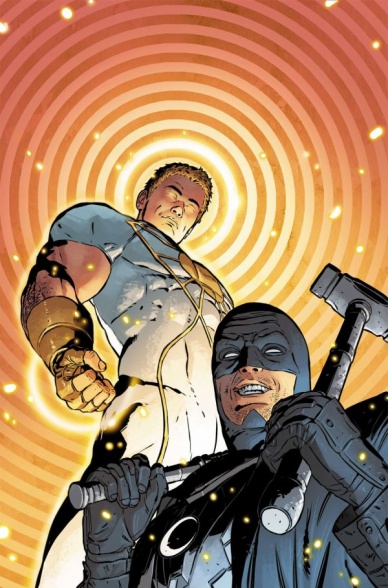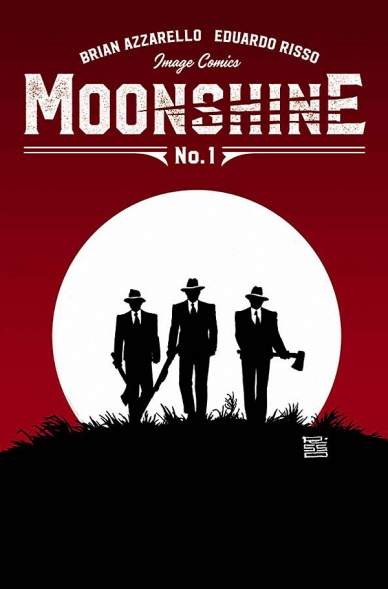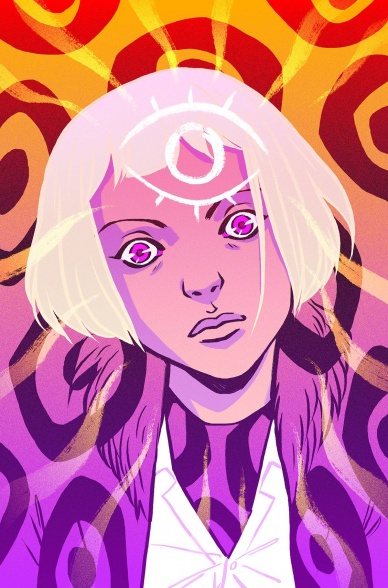There is a lot to cover on Wednesdays. We should know, as collectively, we read an insane amount of comics. Even with a large review staff, it’s hard to get to everything. With that in mind, we’re back with Wrapping Wednesday, where we look at some of the books we missed in what was another great week of comics.
Let’s get this party started.

Betty Boop #1
Written by Roger Langridge
Illustrated by Gisèle Lagacé and Ma. Victoria Robado
Reviewed by Matthew Garcia
Dynamite continues their trend of revitalizing old cartoon characters with “Betty Boop” #1. I have no idea what made them think that Betty Boop was desperately in need of a reboot, but I’m honestly happy they did this. Roger Langridge and Gisèle Lagacé’s “Betty Boop” #1 is a completely charming and pleasant ode to the old Max Fleischer and Grim Natwik cartoon (who aren’t credited as creators for some reason). It’s filled with fun gags and musical numbers while toeing the line of sensuality.
It helps that Lagacé’s art perfectly mimics that ‘30s cartooning style while never sacrificing any modern aesthetics. You see it mostly in the smiles of all the bad guys and the overdramatic expressions of everyone in Betty’s world. There’s movement in the character designs and a nice sense of rhythm to the musical numbers. I think the creative team should be applauded for delivering some well-done musical interludes. It’s not like they’re hitting the beats and measure like a P. Craig Russell strip, but you definitely get a feel for the tempo of the songs. It pays off especially in the climax, when Betty faces down some giant goon in verse.
Langridge and Lagacé provide a plot involving Betty’s grandpa getting evicted from his home by demons or something, but that’s second to the situations and jokes. There are also times when a joke doesn’t fully land, but Langridge and Lagacé keep the story moving so quickly, pack so many gags into the scene, that you forget about it in no time.
The style is classic and the feel is jazzy. “Betty Boop” #1 is very effective and another nice addition to the Dynamite licensed library. (Another final note: it’s rated T+ for some reason? I didn’t see anything that would warrant that rating in this. Give it to a kid, they might enjoy it much more.)
Final Verdict: 7.5 – Jazzy and chill, “Betty Boop” #1 delivers all the thrills.

Dungeons & Dragons: Shadows of the Vampire #5
Written by Jim Zub
Illustrated by Nelson Daniel
Reviewed by Robbie Pleasant
Five issues was never going to be enough to tell the full story of Strahd Von Zarovich. Who could tell a full tale of the journey through Barovia, learning of the vampire’s history, and preparing the party to challenge him? So the comic decided not to make the characters’ goal to defeat Strahd, but to get out of his realm of Barovia. As such, the final issue of the comic is a battle for survival against an overwhelming force.
Yes, a good chunk of the issue is spent showing just how much Strahd outclasses the heroes who readers have grown to know and love throughout IDW’s latest “Dungeons & Dragons” comic run. And to its credit, it is very effective in doing so; in both might and magic, it manages to make Strahd a serious threat, and every hit that the heroes land is one they had to fight hard to earn. It ups the stakes, the tension, and the threat level.
Of course, there’s still some of the enjoyable dialogue and strong characters that we’ve come to expect from these comics. It creates a nice contrast between Strahd’s own soliloquies – the typical “eternal damnation of a vampire, you fools will regret crossing me, etcetera” speech – with the short but snappy witticisms of the protagonists (such as “sword this” or “eat steel, dead-eyes”).
Nelson Daniel’s artwork continues to serve the comic nicely, doing a great job with the action and unique character designs. The combat flows quite nicely, with several panels linking together to show the combat in action, and the character designs remain unique and powerful. A particularly noteworthy moment comes from showing Strahd’s mirror images spell in combat, with each illusionary copy of him speaking a part of Strahd’s lines while he cuts into the heroes.
Continued belowHowever, the conclusion of the comic makes me wonder if the Baldur’s Gate heroes we’ve followed so far have been pulled out of the “Curse of Strahd” storyline just to enter the newly-released “Storm King’s Thunder.” That’s not to say it would necessarily be bad if the comics progressed in tandem with the “Dungeons & Dragons” tabletop storylines as they’re released, but I hope the next arc will have the characters as active participants in the story, rather than observers and members of their own little sideplot.
Final Verdict: 6.8 – a decent finish to the “Shadows of the Vampire” arc, with high threats and good action, although somewhat unfulfilling in how little the characters really managed to accomplish.

Green Valley #1
Written by Max Landis
Illustrated by Giueseppe Camuncoli
Reviewed by Alice W. Castle
“Green Valley” #1 is a comic that wears its intentions on its sleeves in the worst way possible. “Green Valley” #1 is what I can only imagine being able to see the future must be like because at every point of this comic I was able to accurately guess where the story would go from five panels to five pages ahead of where I was. Reading this comic felt like someone had played mad libs with the script for Lethal Weapon and told someone else to illustrate it. From the attempts at witty, irreverent banter that felt like someone had read “Alias” once and though every dialogue scene need to be five pages of the same back and forth to what can only be described as the fridging of the only named female character in the story, “Green Valley” #1 is a collection of overwrought cliches that range from boring to insulting with nothing to say about them.
The artwork from Giuseppe Camuncoli, with inks by Cliff Rathburn, and colours by Jean-Francois Beaulieu, is at least pretty to look at, but there’s not much opportunity for the art to tell the story. All of the story is packed into exposition-laden dialogue meaning the artwork is left to medium closeups of the characters as they stand there and talk to each other. Even the promise of a large battle in the beginning of the issue is nixed in favour in order for our heroes to return to their kingdom unscathed to continue talking to one another in sentence fragments. It is a disappointment through and through, never once taking advantage of the medium or the genre to tell a story that we haven’t seen a million times over instead leaning on a number of cliches that it does nothing to subvert or comment on. In his letter in the backup material of the comic, writer Max Landis calls this a subtle start but promises readers to remain on board because they have no idea what is coming next. My suggestion to Lands would be to actually impress readers with this first issue instead of begging readers to stick with the series after a disappointing first impression.
Final Verdict: 4.1 – I didn’t think it possible for a comic to phone it in, but here we are.

Midnighter & Apollo #1
Written by Steve Orlando
Illustrated by Fernando Blanco
Review by Ken Godberson III
Because we all demanded it, it’s back (for six issues at least). Following from the “Midnighter” series, writer Steve Orlando and colorist Romulo Fajarado Jr. are joined by Fernando Blanco to chronicle the further adventures of the brawler with a supercomputer in his head, this time trying to rebuild his relationship with his godly love Apollo along with trying to stop Henry Bendix’s reign of terror. And really, it’s more about the former than the latter. Orlando has shown full capability on being able to depict these two work together in the field, but it’s the quieter moments -the double date with another couple and the more intimate moments- that resonate the most. Despite the obvious happiness between Midnighter and Apollo, Orlando does a great job of showing the barrier still between them, like Apollo’s concern with M’s first decisions being to kill, despite not wanting to change M. It’s a really nice scene and quite the highlight of the issue.
Continued belowNow on to the art. Fernando Blanco is a welcome edition to this team as he is capable of switching from Midnighter’s more multi-paneled analytical fighting style (as he decimates the Subway Pirates, one of the best things introduced into DC in this century) to Apollo’s more bombastic, widescreen action, like fighting off the Subway Pirates’ “god” which is a giant kaiju made up of subway cars and Apollo uses another subway car to knock it on its ass!
…
Final Verdict: 10- This is the greatest book of the year!
Okay, Okay! It’s not the best book of the year. In spite of taking a character like this and remaking him into this (which had been described by several of my lust-filled friends as “unfair”), there were some kind of off things. Keeping Fajarado on colors was a great idea, keeps consistency, but Apollo always feels like he should be a brighter character and that does feel a bit off by having to conform with the rest of the palate. And while Blanco does a good job on the pencils, there are times that the expression feel a bit wooden. Like, there’s one woman showing shock but it’s so overdone that it circles back around to looking like she’s faking it. These are very minor flaws, but they are there.
Final Verdict: 8.0- You liked “Midnighter”? Well this is that book plus another name in the title!

Written by Brian Azzarello
Illustrated by Eduardo Risso
Reviewed by Liam Budd
“Moonshine” is a brand new comic to come out from Image this week, which sees superstar writer Brian Azzarello team up once again with his “100 Bullets” co-creator Eduardo Risso. This time round, the pair are taking their gritty crime aesthetic to Prohibition era America where we find New York, goon-for-hire Lou Pirlo being sent somewhere in the Appalachian mountains make a deal with the best moonshine makers in the Country. However, not everything is as it seems, as a demonic monster is stalking the woods and just about everybody is acting just a little weird. I have to give it to Azzarello and Risso; you would have thought that Ed Brubaker and Sean Phillips had made it impossible for anybody to touch any type of noir-crime stories, especially at Image, though the team here have gone for a niche enough setting and time frame that I think it stands apart. Though maybe not for the best reasons.
The thing that strikes you immediately about this book is just how hard Azzarello has hit the 1920’s setting, it goes from being a pastiche to straight up spoof and then back again. The main character speaks mostly to the reader through narration that comes across tired and cliched, he frequently reminds us that he is a loner, a heavy drinker and that he’s simply gotten himself caught up with these crazy gangsters and their crazy schemes. It is as if Azzarello has gone through a checklist of noir necessities. There are moments I think even James Cagney would wince, Lou’s boss for instance is called Joe “The Boss” Masseria. And when he’s not talking to us directly, he’s interacting with everybody else in his world in a way that is so disconnected and unnatural. Even for a hard bitten goon in the 20’s. Lou is such an uninteresting character it is hard to connect with this book as everything is so centred around him.
On the other hand, Eduardo Risso does a better job at storytelling, as he has a very capable eye for drama. Risso knows how to play with light and shadow in such a way that it lends the book its only true noir credentials. He can fall into similar, lazy cliches unfortunately, especially when it comes to his designs. Lou’s face is just bafflingly generic and his costume is once again just an amalgamation of every 20’s gangster film that exists. In the end, from its premise to its execution, I found “Moonshine” #1 to be redundant.
Final Verdict: 4.0 – This book is no good, see. Lousy you hear.
Continued below
Shade, the Changing Girl #1
Written by Cecil Castellucci
Illustrated by Marley Zarcone
Reviewed by Brian Salvatore
This is a hard book to review, because I can’t tell how much of my enjoyment of the book was determined by my interaction with the classic “Shade, the Changing Man” book and character. There’s a whole lot packed into this first issue, and a lot of it is steeped in that classic Vertigo history, so it feels like a return of an old friend to people who read those classic stories. It isn’t quite a rehash, though, as Castellucci and Zarcone introduce an entirely new cast and bring a bevy of new elements into the story.
Regardless of whether or not you knew anything about the history, there is a distinct story here that is told in two parts: to put it in extremely simplistic terms, there’s the story of the host and of the parasite, and both are full of intrigue. There’s a young girl who has been in a coma, who was said to be brain dead who, seemingly, just wakes up one day. It turns out that she wakes up because she is inhabited by an alien, but let’s leave that be for now. Zarcone’s art perfectly expresses the complex emotions of all of those in her life – some are relieved, some are terrified by the awakening. The circumstances that led to her coma are, to me, the most interesting parts of the book, and they have nothing to do with aliens or magical clothing.
That’s not to say that the more mystical or sci-fi elements of the book aren’t great, because they are. But the juxtaposition of those two elements together is where I really felt the book excelled. Zarcone balances the two worlds beautifully, and evokes Mike Allred in parts, especially Allred’s ability to keep a book grounded in reality while insanity is happening all around. Zarcone’s work evokes the other books in the ‘Young Animal’ line – a sort of freewheeling yet layered homage to all things comics – but, through the scenes with Megan, both before and after Loma joins her, ground the book in a way I didn’t really expect.
Final Verdict: 8.1 – A strong start to the series that is both reverent to its past and blazing towards an unknown future.






